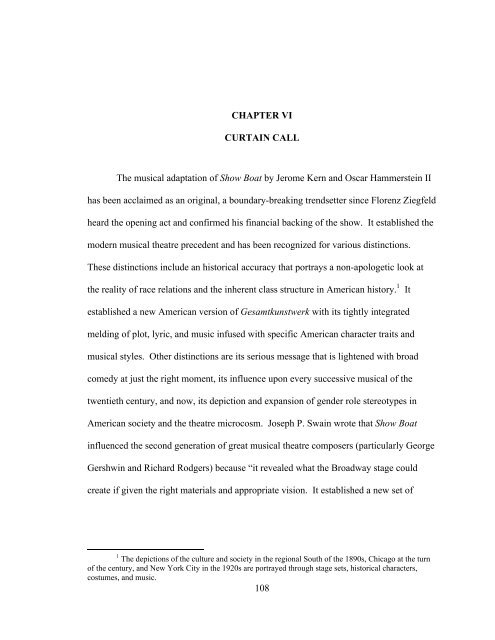Song Character Analysis Worksheet - The University of North ...
Song Character Analysis Worksheet - The University of North ...
Song Character Analysis Worksheet - The University of North ...
Create successful ePaper yourself
Turn your PDF publications into a flip-book with our unique Google optimized e-Paper software.
CHAPTER VI<br />
CURTAIN CALL<br />
<strong>The</strong> musical adaptation <strong>of</strong> Show Boat by Jerome Kern and Oscar Hammerstein II<br />
has been acclaimed as an original, a boundary-breaking trendsetter since Florenz Ziegfeld<br />
heard the opening act and confirmed his financial backing <strong>of</strong> the show. It established the<br />
modern musical theatre precedent and has been recognized for various distinctions.<br />
<strong>The</strong>se distinctions include an historical accuracy that portrays a non-apologetic look at<br />
the reality <strong>of</strong> race relations and the inherent class structure in American history. 1 It<br />
established a new American version <strong>of</strong> Gesamtkunstwerk with its tightly integrated<br />
melding <strong>of</strong> plot, lyric, and music infused with specific American character traits and<br />
musical styles. Other distinctions are its serious message that is lightened with broad<br />
comedy at just the right moment, its influence upon every successive musical <strong>of</strong> the<br />
twentieth century, and now, its depiction and expansion <strong>of</strong> gender role stereotypes in<br />
American society and the theatre microcosm. Joseph P. Swain wrote that Show Boat<br />
influenced the second generation <strong>of</strong> great musical theatre composers (particularly George<br />
Gershwin and Richard Rodgers) because “it revealed what the Broadway stage could<br />
create if given the right materials and appropriate vision. It established a new set <strong>of</strong><br />
1<br />
<strong>The</strong> depictions <strong>of</strong> the culture and society in the regional South <strong>of</strong> the 1890s, Chicago at the turn<br />
<strong>of</strong> the century, and New York City in the 1920s are portrayed through stage sets, historical characters,<br />
costumes, and music.<br />
108

















